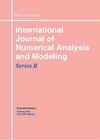基于后处理技术的任意凸多边形网格有限体积元解
IF 0.7
4区 数学
Q1 MATHEMATICS
International Journal of Numerical Analysis and Modeling
Pub Date : 2023-06-01
DOI:10.4208/ijnam2023-1026
引用次数: 0
摘要
本文章由计算机程序翻译,如有差异,请以英文原文为准。
A Finite Volume Element Solution Based on Postprocessing Technique Over Arbitrary Convex Polygonal Meshes
. A special (cid:12)nite volume element method based on postprocessing technique is proposed to solve the anisotropic di(cid:11)usion problem on arbitrary convex polygonal meshes. The shape function of polygonal (cid:12)nite element method is constructed by Wachspress generalized barycentric coordinate, and by adding some element-wise bubble functions to the (cid:12)nite element solution, we get a new (cid:12)nite volume element solution that satis(cid:12)es the local conservation law on a certain dual mesh. The postprocessing algorithm only needs to solve a local linear algebraic system on each primary cell, so that it is easy to implement. More interesting is that, a general construction of the bubble functions is introduced on each polygonal cell, which enables us to prove the existence and uniqueness of the post-processed solution on arbitrary convex polygonal meshes with full anisotropic di(cid:11)usion tensor. The optimal H 1 and L 2 error estimates of the post-processed solution are also obtained. Finally, the local conservation property and convergence of the new polygonal (cid:12)nite volume element solution are veri(cid:12)ed by numerical experiments.
求助全文
通过发布文献求助,成功后即可免费获取论文全文。
去求助
来源期刊
CiteScore
2.10
自引率
9.10%
发文量
1
审稿时长
6-12 weeks
期刊介绍:
The journal is directed to the broad spectrum of researchers in numerical methods throughout science and engineering, and publishes high quality original papers in all fields of numerical analysis and mathematical modeling including: numerical differential equations, scientific computing, linear algebra, control, optimization, and related areas of engineering and scientific applications. The journal welcomes the contribution of original developments of numerical methods, mathematical analysis leading to better understanding of the existing algorithms, and applications of numerical techniques to real engineering and scientific problems. Rigorous studies of the convergence of algorithms, their accuracy and stability, and their computational complexity are appropriate for this journal. Papers addressing new numerical algorithms and techniques, demonstrating the potential of some novel ideas, describing experiments involving new models and simulations for practical problems are also suitable topics for the journal. The journal welcomes survey articles which summarize state of art knowledge and present open problems of particular numerical techniques and mathematical models.

 求助内容:
求助内容: 应助结果提醒方式:
应助结果提醒方式:


